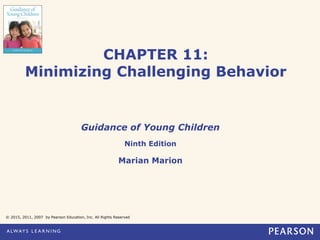More Related Content
Similar to Chapter 11 Minimizing Challenging Behavior (20)
Chapter 11 Minimizing Challenging Behavior
- 2. Marion. Guidance of Young Children, 9e.
© 2015, 2011, 2007 by Pearson Education, Inc. All Rights Reserved
11-2
Challenging Behavior:
What is it?
- 3. Marion. Guidance of Young Children, 9e.
© 2015, 2011, 2007 by Pearson Education, Inc. All Rights Reserved
11-3
Challenging Behavior is in the
‘eye of the beholder’
Each person has a perspective on what they see as
challenging behavior
Our perspective determines the behavior we see and
label as challenging
- 4. Marion. Guidance of Young Children, 9e.
© 2015, 2011, 2007 by Pearson Education, Inc. All Rights Reserved
11-4
Challenging behaviors are the ‘hot
spots’ in a classroom
Hot spot
–Times when a teacher might fell less confident about
his guidance, anxious, impatient, or even angry or
frustrated
–Might question his methods of guiding children
because the positive methods may not be working
with challenging behavior
–Times when teachers perceive that their focus has
shifted form teaching to crisis intervention
Calm and cool times
–Time for teaching with fewer hot-spot, challenging
behaviors, periods of relative peace
- 5. Marion. Guidance of Young Children, 9e.
© 2015, 2011, 2007 by Pearson Education, Inc. All Rights Reserved
11-5
Roots of Challenging Behavior
- 6. Marion. Guidance of Young Children, 9e.
© 2015, 2011, 2007 by Pearson Education, Inc. All Rights Reserved
11-6
Roots of Challenging Behavior:
Developmental Characteristics
Brain development
– Amygdala is the specialist for emotional matters, which is fully
formed at birth
– Frontal lobes help people control themselves and analyze
emotions, not fully developed until adolescence or early adulthood
– Calm-down circuit develops between 10 and 18 months, helps calm
agitation, sends signals between amygdala and prefrontal cortex
Other developmental characteristics
– Young children tend to think about one thing at a time
– Young children have difficulty with perspective taking
– Children who have learned an unhelpful way to do something
retain powerful impales of that incorrect method
– Children feel and express anger but do not understand and cannot
manage anger on their own
- 7. Marion. Guidance of Young Children, 9e.
© 2015, 2011, 2007 by Pearson Education, Inc. All Rights Reserved
11-7
Roots of Challenging Behavior:
Unmet Needs
Basic needs include:
• feeling of being loved and appreciated
• feeling safe and secure
• exercise and physical activity
• sound sleep and rest
• adequate nutrition
• basic medical and dental care
• play
• classroom structure based on principles of
developmentally appropriate practice
• authoritative, constructive guidance
- 8. Marion. Guidance of Young Children, 9e.
© 2015, 2011, 2007 by Pearson Education, Inc. All Rights Reserved
11-8
Roots of Challenging Behavior:
Lack of Skills
Skill deficit-lack of skills needed for getting along
with others and for functioning well in school
Numerous things children must learn to be
successful in relationships in school include:
– Humane treatment of animal
– how to get attention appropriately,
– how to join a group
– how to make and keep a friend
– how to work with others in groups
– how a group functions
– how to stare a project and how to keep it going
- 9. Marion. Guidance of Young Children, 9e.
© 2015, 2011, 2007 by Pearson Education, Inc. All Rights Reserved
11-9
Roots of Challenging Behavior:
Factors in the Classroom
Contextual factors- environmental issues
contributing to challenging behavior
Observing and reflection
–Effective teacher reflect on their own teaching
practices
–Unemotional, dispassionate assessment of
classroom structures and processes
–May use rating scales
–Beneficial to all children
–Unbiased, systematic approaches to choosing a
strategy
–Used by authoritative adults
- 10. Marion. Guidance of Young Children, 9e.
© 2015, 2011, 2007 by Pearson Education, Inc. All Rights Reserved
11-10
(SERVES A FUNCTION)
ALL CHALLENGING
BEHAVIOR HAS A PURPOSE
- 11. Marion. Guidance of Young Children, 9e.
© 2015, 2011, 2007 by Pearson Education, Inc. All Rights Reserved
11-11
Functional behavioral assessment
(FBA)
FBA, enables teachers to figure out the function
that a child’s challenging behavior serves
Data gathered (ABC method used) and analyzed:
Antecedent (what came before the behavior);
Behavior (child’s actions); Consequence (response
following the behavior)
This gives information on what function the
challenging behavior serves
Then, support for more positive behavior can be
offered
- 12. Marion. Guidance of Young Children, 9e.
© 2015, 2011, 2007 by Pearson Education, Inc. All Rights Reserved
11-12
Teasing, tattling, whining, and other
specific challenging behaviors
Use Functional Behavioral Assessment for any
specific challenging behavior
Gather data by using the ABC method
Analyze the data and decide about the function
that a specific behavior serves
Then, offer support for more positive behavior
- 13. Marion. Guidance of Young Children, 9e.
© 2015, 2011, 2007 by Pearson Education, Inc. All Rights Reserved
11-13
Challenging Behavior in Infants
and Toddlers?
Families of some infants and toddlers face great
difficulties
Parents in these families might find it difficult to
provide the support that their infants and toddlers
need
Some very young children, then, show evidence of
delayed social emotional development
This group of children benefits from focused
intervention
Focused intervention is usually done by early
intervention specialists trained specifically to work
with families and young children in their homes

